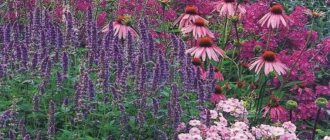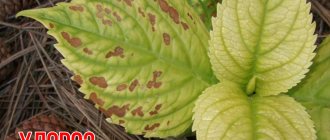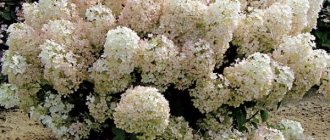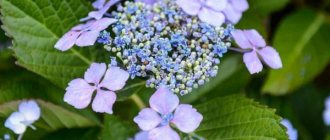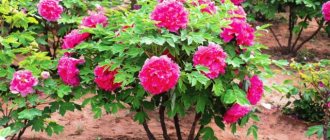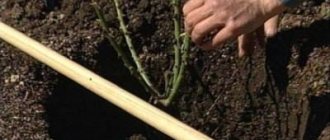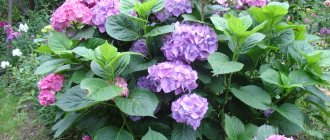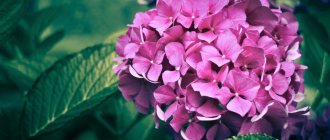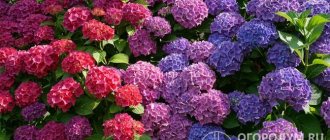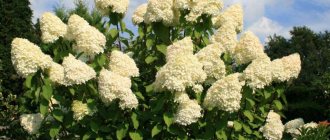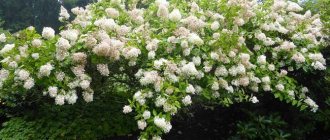Large-leaved, or garden, hydrangea (Hydrangea macrophylla) in its homeland, China and Japan, reaches 4 m in height. In our country it is a low shrub (up to 1 m) with large leaves and blue flowers where the soil is acidic, and pink flowers in slightly alkaline soils.
Most garden forms have spherical inflorescences consisting entirely of sterile flowers. Blooms in July-August.
The most resistant varieties of large-leaved hydrangea are from the Endless Summer, Forever & Ever and You & Me series. They bloom both on last year's shoots and on current year's shoots, which guarantees their annual flowering.
- Directions for selection of large-flowered hydrangeas Form of inflorescences
- Features of flowers
- Variegation
- Endless Summer Series Endless Summer
- Fantasia
- Romance
- Hovaria Love You Kiss Series
- Schloss Wackerbarth
in the photo is a large-leaved hydrangea variety Endless Summer
Directions for breeding large-flowered hydrangeas
The shape of the inflorescences of large-leaved hydrangeas
First of all, the shape depends on which variety of hydrangea participated in the selection: changeable hydrangea (H. macrophylla var. mutabilis), with spherical and hemispherical lush inflorescences, or Japanese hydrangea (H. macrophylla var. japonica), with flat, graceful umbrella-shaped inflorescences.
The main breeding centers of large-leaved hydrangea are located in America, Holland and Japan.
Poisk store offer
Hydrangea large-leaved So Long RosieBuyHydrangea large-leaved So Long SunnyBuyHydrangea large-leaved AishaBuyHydrangea paniculata BoboBuyHydrangea paniculata White LightBuyHydrangea paniculata LamlightBuyHydrangea paniculata PolstarBuyHydrangea paniculata Samme SnowKu drinkHydrangea paniculata PhantomBuyHydrangea paniculata Midlate SammeBuyHydrangea paniculata Magical Sweet SammeBuyHydrangea paniculata Pastel GreenBuy
Features of large-leaved hydrangea flowers
The shape of the petals of sterile flowers in modern varietal hydrangeas is very diverse. They can be:
- wavy (Libertin);
- concave (Hopcorn);
- corrugated (Freepon);
- serrated and fine-toothed (Koria, Twist & Shout).
An interesting direction of selection is that produces flowers located along the edge of flat inflorescences on long stalks. Such inflorescences are found in the Fireworks or Shooting Stars series.
in the photo there is a large-leaved terry hydrangea
Variegation of leaves of large-leaved hydrangea
There are still few varieties of hydrangeas with variegated foliage. Among large-leaved hydrangeas, the most famous varieties are Variegata, Mariesii Variegata, whose green leaves have a white edge, Lemon Wave with yellow variegation, as well as Tricolor and Quadricolor, the foliage of which is covered with white and yellow spots and strokes of different sizes.
in the photo there is a variegated form of large-leaved hydrangea
The color range of large-leaved hydrangea varieties is very diverse - from pure white, pink to red and purple. There are also bicolor varieties or so-called chameleons, which gradually change color.
The most resistant varieties of large-leaved hydrangea
Remontant varieties of large-leaved hydrangeas are positioned as the most winter-hardy. Their distinctive feature is two waves of flowering due to the rapid ripening of the buds of the current year. Remontant varieties are combined into several series. The most popular of them:
- Endless Summer series (abbr. ES);
- the Forever and Ever series (abbr. FE), created on the basis of the Early Sensation variety, more frost-resistant than ES;
- You and Me series (abbr. YM), almost all varieties of the series are terry.
Endless Summer hydrangea series
The Endless Summer series includes Bailmer (The Original), Blushing Bride, Twist-n-Shout (PIIHM-1) and Bloom Struck (Bloom Star). All varieties have bright large inflorescences, usually round in shape. The exception is the Twist-and-Shout variety with a flat bud shape.
variety of large-leaved hydrangea Endless Summer
The first variety of large-leaved hydrangea, capable of blooming on the shoots of the current year, gave its name to a whole series of varieties. For its ability to bloom again, the variety was named Endless Summer, which means “Endless Summer”.
Bush 1–1.5 m high. Inflorescences are spherical, up to 15 cm in diameter. The color changes depending on the acidity of the soil. The variety is characterized by increased winter hardiness. Even if the buds on last year’s wood suffer in winter, the young shoots will still bloom.
in the photo is a large-leaved hydrangea variety Endless Summer
Unfortunately, you may encounter confusion in the names of varieties. So, if you want to purchase the Endless Summer variety, you can find varieties on sale called Endless Summer Blue, Bailmer or Endless Summer Bailmer Blue. However, these are just the same variety.
variety of large-leaved hydrangea Blue Bloom Star
An adult bush can reach 1.2 m in height and width. The shoots are burgundy and strong. The veins on the leaf blade are burgundy. The variety blooms in large spherical inflorescences with a diameter of 15–18 cm, consisting of sterile pink or blue flowers. The leaves are resistant to powdery mildew.
variety of large-leaved hydrangea Twist & Shout
A bush about 1 m high and wide. A variety with lacy flat inflorescences, in the middle of which there are small fertile flowers, surrounded by a necklace of large sterile pink flowers. The edges of the leaves are finely toothed. The diameter of the inflorescences is from 10 to 16 cm.
For more active re-blooming, it is necessary to prune previously faded inflorescences.
large-leaved hydrangea variety Blushing Bride
One of the new products in the series is a variety with a beautiful name, which translates as “shy bride.”
A bush up to 1.5 m high and about 1 m wide with white inflorescences with a slight pinkish tint. The variety is most resistant to diseases. Resistant to chlorosis.
What are the problems when growing?
They are often akin to other flower crops:
- if the root of the plant was not covered in frosts, in the spring it will begin to rot and the growth of the plant will slow down, this also happens when loosening is too deep;
- if the leaves begin to turn yellow and the flowers are small, try to somehow shade the plant;
- growth may slow down due to watering with hard water, use softening agents;
- among diseases, hydrangea is often affected by powdery mildew and white rot; they are combated with special preparations or folk remedies - infusion of garlic or mustard;
- Among the pests it is often attacked by spider mites and slugs; a soap solution or fungicides are used to treat insects, and slugs will simply go away if you place pieces of copper next to the garden bed.
If hydrangea stubbornly refuses to bloom, you also need to look for the reason:
- improper pruning of shoots;
- the buds froze in winter;
- It has already been said that hydrangea does not bloom well in bright sunlight;
- Perhaps you should increase watering or provide additional fertilizing.
In any case, it is better to prevent any difficulties. In addition, hydrangea is considered an unpretentious plant.
Often all these troubles are explained by the fact that the plant froze in winter.
That is why pests begin to attack it, diseases besiege it, and the hydrangea begins to have problems with development.
Try to remove all dry shoots, even to the detriment of future flowering. We may have to give up waiting for blossoms this year.
But hydrangeas are strong plants, and if you support them, the next season will definitely delight you with flowers. In conclusion, it remains to add that caring for hydrangeas should begin with the choice of planting site. These flowers look great next to the fence: there is more shade and the landscape is decorated. And if you add several flowering crops nearby to the garden bed, the area will generally sparkle with fresh rainbow colors. The Japanese call these flowers pink-violet sun.
Forever & Ever hydrangea series
Based on the Early Sensation variety, another commercially successful Forever & Ever series was eventually created. Currently it consists of varieties Early Sensation (trade name Forever & Ever Pink/Blue), Red Sensation, White Ball, Pepermint, Fantasia. The varieties can withstand temperatures down to -20...-24 °C. Even with light shelter, plants are quite capable of surviving the winter without serious problems.
large-leaved hydrangea variety Fantasia
A remontant variety with a unique combination of colors: from light green to bright green, red and crimson.
variety of large-leaved hydrangea Red Sensation
The title translates as "Red Sensation". When artificially dyed, burgundy-red inflorescences can change color to purple-burgundy.
The bush is compact, 60–90 cm high. The inflorescences are spherical, 10–12 cm in diameter. At the beginning of flowering, the flowers are bright scarlet with a brilliant tint; by autumn they acquire a duller pastel color in burgundy tones. Winters under cover.
In the photo there is a variety of large-leaved hydrangea Forever & Ever Red
large-leaved hydrangea variety Peppermint
Delicate pink petals with a white border along the edges, inflorescences reach 20 cm in diameter.
A miniature bush 60–70 cm high. It is frost-resistant and does not require shelter.
Also popular from the same series are the snow-white White Ball and the bright blue Blue Heaven.
How to plant correctly?
There are several ways to propagate this plant:
- cuttings;
- layering from the bottom of the stem;
- dividing the bush along with the root system.
The seed option is also possible, but in this case the seedling will have to be grown for about 2 years.
Optimal timing
They are different for different planting methods:
- green cuttings are used in July during the formation of buds;
- layering is used in the spring, when the buds have not yet bloomed;
- Dividing the bush is also done in the spring;
- Growing seeds for seedlings begins in the fall.
With all methods, it is necessary to take into account weather conditions and the condition of the seed.
Preparing the site and material
It also has its own characteristics:
- shoots are selected from the lower shoots, the soil is prepared with peat;
- to germinate branches, simply dig up the soil around the bush;
- when dividing a bush, it should be thoroughly washed, washing away all remaining soil, and the weak ends should be separated;
- To grow seedlings from seeds, you should prepare a mixture of garden soil, peat and sand.
You can also use store-bought soil, only with a low nitrogen and lime content.
In any case, only viable, disinfected planting material should be used. When preparing seeds, the shelf life must be taken into account. It is advisable to keep them a little before planting in a solution of potassium permanganate and even germinate them a little in a nutrient solution.
Step-by-step instruction
Planting in various ways is done as follows:
- cuttings are cut in the morning, leaving 2-3 leaves, treated with a root growth stimulator, planted in peat and covered;
- the branches are laid on the ground and covered with earth; by autumn they will sprout;
- the divided root is planted immediately after washing;
- Flower seeds are planted in prepared pots, cups or cassettes, picking is carried out twice as they grow, and they are planted in the ground only for the 2nd year.
All planting actions must be accompanied by good watering and subsequent fertilizing.
Hydrangea series You & Me
It consists of remontant varieties - Romance, Together and Expression and also winter-hardy, but not remontant: Forever, Symphony (purple) and Eternity.
variety of large-leaved hydrangea Romance
Pink double flowers open gradually from the edge to the center of the inflorescence. Delicate flowers resemble double stars.
in the photo there is a variety of large-leaved hydrangea Romance
large-leaved hydrangea variety Together
A variety with double flowers: greenish when blooming, then pale lilac. At the same time, there are flowers of both colors on the bush at the same time.
In the photo there is a variety of large-leaved hydrangea Together
large-leaved hydrangea variety Expression
The inflorescences consist of large pink double flowers.
large-leaved hydrangea variety Eternity
A variety with double pink star-shaped flowers.
large-leaved hydrangea variety You & Me Love
New terry variety! Awarded a gold medal from the National Plant Show.
Double flowers, two-color at the beginning of flowering: pink and cream. Color may vary depending on soil acidity. The inflorescences are dense, up to 20 cm in diameter. The variety is remontant.
How to care?
Caring for the plant is not very difficult, but care must be constant. Particular attention should be paid to wintering. Different varieties withstand it differently.
Fertilizer
If you do not feed the flower, it is impossible to achieve beautiful and long flowering. Hydrangea is a good indicator of the owner's gardening skills. If there are a lot of inflorescences, the flowers are bright and voluminous, it means that the remaining crops on the site are maintained correctly. When applying fertilizers, the following factors should be taken into account:
- fertilizing is carried out at least twice - before flowering and after;
- in spring, the most suitable option is a urea solution;
- after flowering it is better to use complex mineral fertilizers;
- During the season, you can apply slurry, if possible.
You cannot overdo it when feeding with manure. In this case, the inflorescences grow quickly and often simply break the bush.
Watering
It is considered the most important condition for the successful maintenance of hydrangea:
- in hot weather it is recommended to water the flowers twice a week;
- the bush will require up to 50 liters of warm water;
- if peat was used in the soil, the volume can be reduced to 25 liters.
We should not forget about loosening. Hydrangeas also need it to saturate the soil with oxygen.
Trimming
There is no need to rush here; pruning should be done on 3-year-old or even 4-year-old plants:
- varieties that bloom on this year's shoots are pruned in early spring before buds open;
- if pruning is done after sap flow begins, the plant may die;
- It should be remembered that cuttings cut at this time are not suitable for rooting.
In many ways, this procedure depends on the formation of the bush and its expected size. At the same time, tree hydrangea is pruned more carefully, large-leaved hydrangea is only slightly rejuvenated and diseased or broken branches are removed.
How to care in winter?
Some gardeners do not cover hydrangeas for the winter, especially frost-resistant varieties, but it is still better to take care of the green pets. It is recommended to start the procedure in early October, immediately after the first frost:
- young bushes can simply be bent and covered with earth;
- mature bushes are covered with roofing felt, which is weighted on the sides with bricks;
- for large bushes, frames are built and covered with special insulating material.
Usually all species are filmed in April, when the temperature reaches above zero.
Hovaria hydrangea series
A series of remontant varieties, one of the most resistant to frost and disease. The series is characterized by combinations of pink-red and greenish colors.
large-leaved hydrangea variety Love You Kiss
A very beautiful variety, blooming with white flowers with bright pink ruffles.
in the photo there is a large-leaved hydrangea variety Love You Kiss
large-leaved hydrangea variety Hopcorn
A variety of hydrangea with dense inflorescences of flowers with rounded petals. The color of flowers in alkaline and neutral soil will be dark pink, in acidic soil - violet-blue.
large-leaved hydrangea variety Hobella
A fairly new variety that changes color from soft pink to cherry red. The transition from one color to another passes through a greenish tint.
large-leaved hydrangea variety Riple
Quite large, up to 1.2 m in height, with very strong shoots. It is distinguished by large white-pink spherical inflorescences.
variety of large-leaved hydrangea Sweet Fantasy
The bush is dense. The flowers are variegated: pink with red splashes. The fall foliage is yellow with red spots.
More varieties of large-leaved hydrangea
And a few more varieties of large-leaved hydrangea that can be found on sale. However, most are best grown in container culture.
large-leaved hydrangea variety Schloss Wackerbarth
A very beautiful and unusual variety.
The inflorescence is spherical, dense and quite large. Red-crimson flowers with a blue-violet center. The more acidic the soil, the brighter the blue color. Towards the end of flowering, the ends of the petals turn green.
More suitable for growing in container culture.
In the photo there is a variety of large-leaved hydrangea Schloss Wackerbarth
variety of large-leaved hydrangea White Wave
Bush up to 1.2 m high. White inflorescences with various shades of pink or blue.
In the photo there is a variety of large-leaved hydrangea White Wave
large-leaved hydrangea variety Fireworks White / Hanabi
A unique variety of hydrangea with star-shaped double flowers.
Bush with dark leaves. The inflorescences are lacy, large. Fertile flowers are pale pink or blue depending on the acidity of the soil, sterile flowers are white double stars.
Suitable for growing in container culture.
in the photo below is the variety of large-leaved hydrangea Nightingale, above is the variety of hydrangea Hanabi / Fuji Waterfall
variety of large-leaved hydrangea Nikko Blue
Nikko Blue is considered a real star among blue-flowered hydrangeas.
This is a remontant hydrangea. The bright blue color appears only on acidic soil. On neutral and alkaline, its color becomes almost white.
In the photo there is a variety of large-leaved hydrangea Nikko Blue
large-leaved hydrangea variety Ayesha
Bush up to 0.9–1 m. The flowers are initially creamy-white, then light pink or pale lilac depending on the acidity of the soil. Requires shelter for the winter, winter hardiness zone 5–6.
The variety is suitable for growing in container culture.
In the photo there is a variety of large-leaved hydrangea Ayesha
variety of large-leaved hydrangea Early Blue
Bush 0.8–1.2 m. Blooms on last year's shoots, inflorescences are blue, spherical.
Description of the flower
Large-leaved hydrangea is a shrub slightly higher than 1 m, characterized by compactness. It has characteristic flowers, united in inflorescences, and those in the middle are smaller in size, and those on the outskirts are larger. This gives the whole plant a unique and attractive appearance.
Hydrangeas have a curious feature: their inflorescences can change color throughout the season. This may occur seasonally or due to changes in soil composition.
The leaves of the plant are pointed, long or oval. All types of hydrangea have basal shoots. The shrub goes well with many ornamental flower crops, so it is often used in landscape design.
